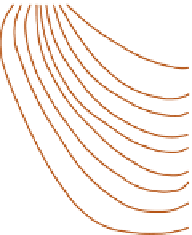Geoscience Reference
In-Depth Information
N
Vernal equinox
21 March
Plane of the ecliptic
Winter solstice
22 December
Summer solstice
21 June
Day
Night
Sun's rays
Sun
Day
Night
Circle of
illumination
c
Autumn equinox
23 September
Figure 2.12
The revolution of Earth around the sun. The seasons are the result of Earth's tilted axis having a constant
orientation in space as Earth revolves around the sun. Distances and sizes are not to scale.
Feb
4
Mar
21
May
6
June
22
Aug
8
Sept
23
Nov
8
Dec
22
hemisphere. For example, the altitude of the sun at solar
noon in Hong Kong (latitude 22
90°N
80
70
60
50
40
30
20
10
0
10
20
30
40
50
60
70
80
90°S
N) would be:
0
0
50
100
150
200
250
300
22 December
Altitude = 90
50
500
100
- 22
- 23·5
150
Altitude = 44·5
250
200
350
400
350
300
400
21 March
Altitude = 90
450
- 22
- 0
Altitude = 68
400
350
300
250
200
450
21 June
Altitude = 90
- 22
+ 23·5
450
Altitude = 91·5
150
100
50
500
(The value above 90
means the sun is slightly to the north
of an overhead position.) Try this out for your own
latitude to work out the range of solar altitude from
winter to summer.
The presence of Earth's atmosphere has a dramatic
effect on the amount of radiant energy which reaches the
surface, but we can illustrate the essentially astronomic
controls of the input either at the top of the atmosphere
or by assuming there was no atmosphere; the result is the
500
0
550
Jan
Feb
Mar
Apr May Jun
Jul
Aug Sep
Oct
Nov
Dec
surface assuming no atmosphere by latitude and time of year.
Purple areas receive no solar radiation.
Source: After Neiburger et al. (1982)


































































































































































